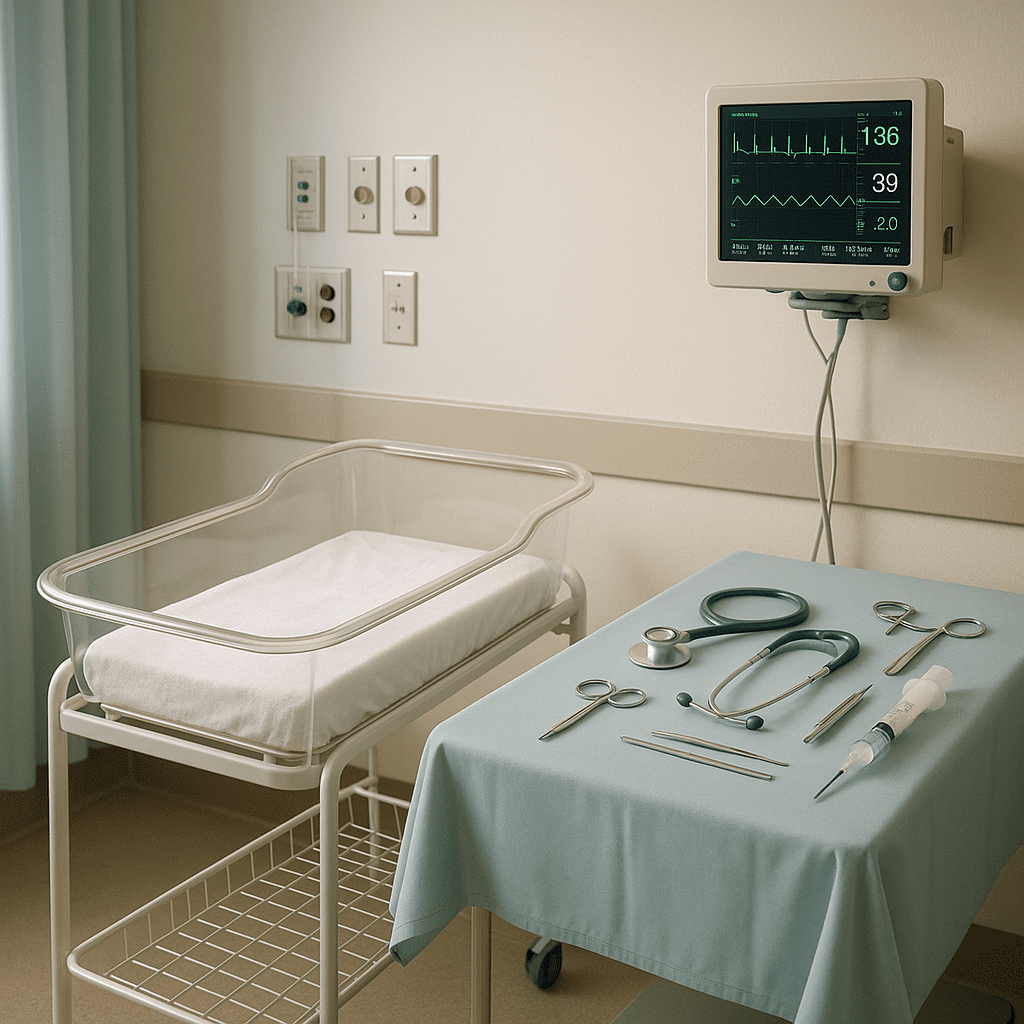The first 24 hours of life are critical for every newborn, and nurses play a key role in ensuring a smooth transition from intrauterine to extrauterine life. A thorough newborn assessment allows early identification of potential complications and supports family education and bonding. For every registered nurse (RN nurse), mastering this assessment is not only vital for safe clinical practice but also essential for NCLEX success.
🩺 Importance of the Newborn Assessment
The newborn assessment evaluates how well a baby adapts to life outside the womb. It involves checking vital signs, physical characteristics, reflexes, and overall well-being. Early findings guide interventions that promote optimal health and prevent complications such as hypothermia, hypoglycemia, or respiratory distress.
Performing a systematic and gentle assessment builds trust with the family and sets the tone for holistic, family-centered nursing care.
🕐 What Nurses Should Assess in the First 24 Hours
1. Apgar Score
The Apgar test is performed at 1 minute and 5 minutes after birth.
Each category is scored from 0 to 2, with a maximum of 10.
| Category | 0 | 1 | 2 |
|---|---|---|---|
| Heart Rate | Absent | <100 bpm | >100 bpm |
| Respiratory Effort | Absent | Slow/irregular | Good cry |
| Muscle Tone | Limp | Some flexion | Active motion |
| Reflex Irritability | No response | Grimace | Vigorous cry |
| Color | Blue/pale | Body pink, extremities blue | Completely pink |
Nursing Note: A total score of 7–10 indicates good adaptation. Lower scores require immediate resuscitative efforts and continuous monitoring.
2. Vital Signs
Within the first hour and regularly afterward, assess:
- Temperature: 36.5–37.5°C (97.7–99.5°F)
- Heart Rate: 110–160 bpm
- Respirations: 30–60 per minute
- Blood Pressure: Average 60/40 mmHg
Nursing Tip: Keep the newborn warm and dry, as hypothermia can quickly lead to hypoglycemia and respiratory distress.
3. Physical Examination
Perform a head-to-toe assessment:
- Head: Check fontanels (should be soft and flat) and molding.
- Eyes: Look for red reflex, discharge, or asymmetry.
- Skin: Assess for jaundice, bruising, or vernix.
- Chest: Note symmetrical expansion and breath sounds.
- Abdomen: Check umbilical cord for bleeding or signs of infection.
- Genitalia: Verify normal anatomy and urination.
- Extremities: Observe movement, symmetry, and reflexes.
Nursing Bundle Tip: Document findings clearly in the newborn record — this helps track progress and identify emerging issues early.
4. Reflexes
Normal neonatal reflexes include:
- Moro (startle) reflex
- Rooting and sucking reflexes
- Palmar and plantar grasp
- Babinski reflex
Absence or asymmetry may indicate neurological problems requiring further evaluation.
5. Thermoregulation
Newborns lose heat rapidly. Nurses must:
- Dry the baby immediately after birth
- Use skin-to-skin contact or radiant warmers
- Monitor axillary temperature frequently
Registered nurses should educate parents on maintaining warmth, especially during transport or bathing.
6. Feeding and Elimination
Assess feeding patterns and note the first void and stool (meconium).
Failure to void within 24 hours or pass meconium within 48 hours should be reported immediately.
RN Nurse Tip: Monitor for signs of dehydration, such as poor skin turgor or sunken fontanels.
7. Glucose Monitoring
Check for hypoglycemia in high-risk newborns (infants of diabetic mothers, preterm, or large-for-gestational-age).
Normal glucose level: >40 mg/dL (2.2 mmol/L).
Nursing Intervention: Feed early and monitor for jitteriness or lethargy.
8. Parental Bonding
Support emotional connection between parents and newborn. Encourage skin-to-skin contact, early breastfeeding, and rooming-in. This helps stabilize the newborn’s vital signs and promotes family-centered nursing care.
🧠 NCLEX Tips for Nurses
Expect NCLEX questions on:
- Prioritizing newborn assessments (Apgar first!)
- Identifying abnormal findings
- Thermoregulation and glucose management
- Parental education and bonding
Remember: Safety and early intervention are top priorities.
🩹 Nursing Care Plan for the First 24 Hours
- Assessment: Vital signs, color, reflexes, feeding pattern
- Diagnosis: Risk for hypothermia, risk for ineffective breathing pattern
- Interventions: Maintain warmth, monitor glucose, assist with feeding
- Evaluation: Stable temperature, effective feeding, strong cry, active reflexes
📦 How Nursing Bundles Help
A nursing bundle provides structured, easy-to-follow checklists and visual guides for newborn assessments. These bundles simplify complex steps, helping nurses and RN nurses confidently perform accurate evaluations and prepare effectively for the NCLEX.
💡 Key Takeaway for Registered Nurses
Early assessment saves lives. For every registered nurse, mastering newborn evaluation is about more than clinical accuracy—it’s about ensuring safety, comfort, and a healthy start to life.
🍼 FAQ: Newborn Assessment – First 24 Hours
A registered nurse (RN nurse) should assess the newborn’s vital signs — temperature, heart rate, respirations, and oxygen saturation — along with reflexes, skin color, muscle tone, and feeding ability. This comprehensive newborn assessment helps identify any early signs of distress or complications.
For NCLEX and clinical practice, remember these ranges:
Heart rate: 110–160 beats per minute
Respiratory rate: 30–60 breaths per minute
Temperature: 97.7–99.5°F (36.5–37.5°C)
Blood pressure: around 65/40 mmHg
Knowing these values helps nursing students and registered nurses provide safe, evidence-based care.
The first 24 hours are critical because the newborn must adapt from intrauterine to extrauterine life. Nurses monitor for signs of respiratory distress, hypoglycemia, temperature instability, or infection — conditions that can rapidly progress if not detected early.
During the initial newborn assessment, the nurse should evaluate key reflexes such as the Moro (startle) reflex, rooting, sucking, grasp, and Babinski. These reflexes indicate normal neurological function and development.

